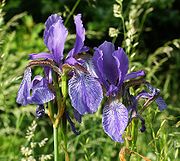Königsauer moss
Situation map |
Coordinates: 48 ° 40 ′ 30 ″ N , 12 ° 32 ′ 7 ″ E


The Königsauer Moos is a fen area in the lower Isar valley . It extends from the west ( state road 2111 near Dingolfing ) to the east ( St 2114 near Großköllnbach ) over a length of 10.3 km² north of the A 92 and south of the district road DGF 10 . The area essentially extends over the districts of Lengthal , Moosthenning , Thürnthenning and Ottering (municipality of Moosthenning) and over the district of Großköllnbach (municipality of Pilsting ). It also contains smaller peripheral areas in the north of the municipalities or districts of the cities of Dingolfing , Gottfrieding and Mamming , where these extend north of the A92. It has an area of 1300 hectares and is one of the last great low-moor areas in Bavaria is. What matters is the name Einödhof Königsau in the district Ottering in the northeast of the area.
Flora and fauna
Within the Königsauer Moos are 130 hectares of biotope areas and 270 hectares of contractual nature conservation areas . Around 150,000 euros a year are spent on this from the public purse. In Königsauer moss 40% live in the Bavarian stock of curlews . 90% of the Lower Bavarian gray chambers live here. The Königsauer Moos is a retreat for low- moor-specific animal and plant species (e.g. flour primrose , sedge devil , blue ant , great golden insect , garlic toad ). In spring and autumn , the Königsauer Moos is an important resting place for international bird migration . Over 120 bird species have already been identified. In 2004 the Königsauer Moos was included in the European natural heritage as a bird sanctuary (SPA).
Bird species in the Königsauer Moos

- Winter guests: Hen harrier , buzzard , great egret , wood sandpiper .
- Breeding bird species: Marsh harrier , meadow harrier , curlew , lapwing as colony breeder, gray bunting, yellow wagtail , quail , partridge , bluethroat , whinchat , whinchat .
-
Migrant: white stork , black stork , Ruff , Wood Sandpiper , Green Sandpiper, teal , shoveler , northern wheatear , Tawny Pipit , Red-throated Pipit , Kranich .
Hazards and protective measures

The quality of the Königsauer Moos as a bird sanctuary is impaired and endangered in the long term by major events on the edge of the area, by dogs running freely , by creeping lowering of the groundwater , by increasingly scarce financial resources to compensate for the care of meadows and by willful backfilling of sinks. To improve the habitats in the Königsauer Moos, environmental friends ( BN , LBV , also sponsors such as banks and shops) try to stop the creeping drying out of the fens at least in the main area of the Königsauer Moos . The following measures are important here: creation of ponds and lakes (unevenness in floodplains), ditch widening and the conversion of arable land into meadows , as well as land purchases and the rounding off of the land for sale.
Individual evidence
- ↑ Königsauer Moos Geotop ( Memento of the original from March 4, 2016 in the Internet Archive ) Info: The archive link was inserted automatically and has not yet been checked. Please check the original and archive link according to the instructions and then remove this notice.
Web links
- Report from the Königsauer Moos with photos ( Memento from September 27, 2007 in the Internet Archive )
- Map with demarcation of the Königsauer Moos



